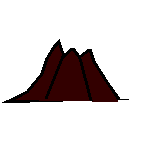
Miss McMichael's
Lesson Designs
Summarization is Exploding
Rationale: Students need to learn to read for many reasons but the most important reason is to learn to comprehend. One strategy for learning to comprehend text is to summarize. Summarization is skill used when reading to learn. Summarization will also help students eliminate unnecessary information so they can focus on the main topic of the text.
Materials:
-
Pencils
-
Class set of “How Volcanoes Form” Article
-
Highlighters
Procedures:
-
Say: Now that we have all become fluent readers, let’s become good readers! An important factor in becoming a good reader is to understand what we are reading. A page of texts can contain hundreds of words and it would take forever to remember all the details in a text you read, so instead we use a strategy called summarization. Summarization helps us you remember the important points of text rather than minor details. Summarizing is like reducing a passage into a short description. We will practice summarizing and then you will each try some on your own.
-
Say: Today, we are going to read an article about volcanoes. In the article, the word erupt will be used. Does anyone know what erupt mean? [Wait for response]. When a volcano erupts it is almost like an explosion of hot ash and lava. So is an eruption when a volcano is inactive and silent? [Wait for response]. Very good! No it is not, its when hot ash and lave are blasting out of the volcano.
-
Say: Before we start reading I have a few instructions for you to help you summarize. First, we want to discover what the main idea of the article is. Second, I want you to highlight important facts in the article. Third, I want you to write a few short sentences summarizing the article you read.
-
Say: We are going to read the first paragraph of “How Volcanoes Form” together. Lets begin by reading the first sentence. “In 1980 in Washington, after 123 years of hibernation, Mount St. Helens erupted.” That sounds pretty important to me. Lets highlight the first sentence. Now let’s continue reading. “The blast destroyed and scorched 230 square miles (370 square kilometers) of forest within minutes. The eruption released an avalanche of hot ash, gas, steam, and rocks that mowed down giant trees up to 15 miles (24 kilometers) away.” That seems like a pretty specific detail that is probably not essential. Let’s continue reading. “When magma finds a way to escape from beneath the earth’s surface, it creates a volcano.” The title is “How Volcanoes Form” so I bet that sentence is important, let’s highlight it.
-
Say: Now that we have read the first paragraph let’s create a topic sentence for the paragraph we read. When constructing a topic sentence we want to combine the important information. Let me show you. “ After 123 years of hibernation, Mount St. Helens erupted when it’s magma found a way to escape beneath the earth’s surface.” Do you see how I put both important facts into one sentence?
-
Say: There are a few more paragraphs in this article and I want you to finish reading to summarize the rest of the article. Don’t forget to highlight the important information. After you have finished highlighting then write a few sentences to help summarize the article you read. Be sure you are doing a good job summarizing because we will have a quiz.
Assessment: Students will take a short quiz on the article they read and I will also collect their articles to determine if they are summarizing correctly.
Quiz
-
When magma escapes from beneath the earth’s surface, what is created?
-
Which volcano eruption causes most of volcano-related fatalities?
-
Name two different ways a volcano can erupt?
-
What does a volcano eruption forever change?
Summarize Checklist
-
____ Highlighted important facts
-
____ Found meaningful facts in each paragraph
-
____ Summary sentences make sense
-
____ Sentences fit together and summarize the article
References:
Volcano. (n.d.). Retrieved November 8, 2015, from http://kids.nationalgeographic.com/explore/science/volcano/#volcano-explode.jpg
Murray, Bruce. Using About-Point to Awaken the Main Idea
http://www.auburn.edu/academic/education/reading_genie/AboutPointRL.html
Stewart, Kaley. Summarizing with Sea Turtles
http://kms0072.wix.com/sweetreads#!about1/c1p2t
